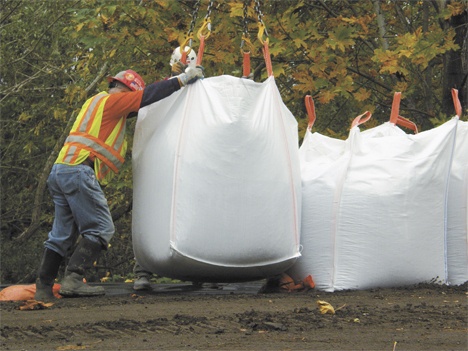To protect life and property against potential flooding of the Green River this fall and winter, the City of Auburn last week began setting up a bulwark of giant sandbags and barriers atop the levees along the west side of the river between 8th Street Northeast and the River Mobile Home Park.
Supersacks, giant sandbags filled with 3,500-4,000 pounds of sand, will do most of the work primarily on the Dykstra levee, Lone’s Addition levee and the Reddington levee adjacent to the River Mobile Home Park.
Public Works Director Dennis Dowdy said the City’s authorization from the King County Flood Control District and it will build the levees up to contain 13,900 cubic feet of water each second with a safety factor of three feet of free space on top.
“That is almost 2,000 feet above its designed capacity,” Dowdy said.
The bags will be enfolded in thick black plastic to protect them from ultraviolet rays and lengthen their lifespan. The City expects them to be there for five years or until the Corps completes the barrier wall at Howard Hanson Dam that will restore it to its full capacity.
At the end of the Reddington levee, containment will cut west across school district property and open fields to the I Street corridor, where it will turn north.
“Across the field west of the Reddington levee and as we go north on I Street, we will be using the HESCO Barriers, accordion-pleated cages filled with rock,” said Sarah Miller, City of Auburn emergency preparedness manager. “… Containment is going up, that’s the important part.”
There is no levee on either side of the river north from there to 272nd. He said the City will set up HESCO barriers north to the theater property where the barrier will tie into 277th Street. He estimated the flood wall at the theater property will be about 12-feet high.
Dowdy said South 277th to Auburn Way North probably will become a dike in a flood event. During a 13,900 cfs event, the bridge at Central Avenue in Kent will overflow on the left bank about a half-foot higher than the low points on South 277th, he said, so if the City did nothing, water would flow back over the roadway and close it anyway.
“Our plan is to move forward with some sort of rapid-deployment devices,” Dowdy said. “The plan so far … is to pre-locate jersey barriers across that roadway, and just prior to the time we need to close that road for safety anyway, we will close off that portion of south 277th so it becomes a dike for however many weeks we need.”
Dowdy said that the City probably will have to dam the railroad ditches to keep the flows from coming back over them and into the city.
There are no levees or dikes along the east side of the river, the City cannot set up flood protection measures there.
The King County Flood Control District, which owns the levees and the levee system, first had to secure approval from the U.S. Army Corps of Engineers. Ultimately, it is a federal decision that allows work on the levees because they are one part of a flood control system that works in conjunction with the Howard Hanson Dam. They are designed as a system to work together, so the Corps has to make sure that what is happening on the levees makes things better, not worse.
“How confident are we in the containment?” Miller asked. “That’s a good question. We are more confident than we would be without it; however, we are not confident enough to let people in there once the river fills the bank at the 13,000 to 13,900 cfs level. If that happens, we will still evacuate people, because we don’t want somebody in there if one of those secondary containment measures fails.”
King County allocated $8.4 million to be split among the four Green River cities of Auburn, Kent, Tukwila and Renton. Auburn’s share is $1.2 million.
“With work on levees and barriers north up to South 277th, I feel we’ve got a better chance of keeping our community safe. But I am also aware of the fact that nature rarely does what we expect it to do,” said Auburn Mayor Pete Lewis.
Lewis’ concern is for the levees and the hard season ahead.
“If we receive more than one flood, even if it is minor, it can wear away at a temporary levee. My biggest concern might not be the first, but the second or third high-water event. It may be only a matter of time before water eats through the temporary barriers,” Lewis said.



